Abstract
Syntactic theory provides a rich array of representational assumptions about linguistic knowledge and processes. Such detailed and independently motivated constraints on grammatical knowledge ought to play a role in sentence comprehension. However most grammar-based explanations of processing difficulty in the literature have attempted to use grammatical representations and processes per se to explain processing difficulty. They did not take into account that the description of higher cognition in mind and brain encompasses two levels: on the one hand, at the macrolevel, symbolic computation is performed, and on the other hand, at the microlevel, computation is achieved through processes within a dynamical system. One critical question is therefore how linguistic theory and dynamical systems can be unified to provide an explanation for processing effects. Here, we present such a unification for a particular account to syntactic theory: namely a parser for Stabler’s Minimalist Grammars, in the framework of Smolensky’s Integrated Connectionist/Symbolic architectures. In simulations we demonstrate that the connectionist minimalist parser produces predictions which mirror global empirical findings from psycholinguistic research.


















Similar content being viewed by others
Notes
Note that “the girl” is already a phrase that could have been obtained by merging “the” ( d ) and “girl” ( n ) together. We have omitted this step for the sake of simplicity.
Each lexical item corresponds to one node, further a root node with two daughters consists of three nodes in total (parent, left daughter, right daughter). A merge operation adds one node, while move increases the node count by two.
References
Bader M (1996) Sprachverstehen: Syntax und Prosodie beim Lesen. Westdeutscher Verlag, Opladen
Bader M, Meng M (1999) Subject-object ambiguities in German embedded clauses: an across-the-board comparision. J Psycholinguist Res 28(2):121–143
beim Graben P, Gerth S, Vasishth S (2008a) Towards dynamical system models of language-related brain potentials. Cogn Neurodyn 2(3):229–255
beim Graben P, Pinotsis D, Saddy D, Potthast R (2008b) Language processing with dynamic fields. Cogn Neurodyn 2(2):79–88
beim Graben P, Atmanspacher H (2009) Extending the philosophical significance of the idea of complementarity. In: Atmanspacher H, Primas H (eds) Recasting reality. Springer, Berlin, pp 99–113
beim Graben P, Potthast R (2009) Inverse problems in dynamic cognitive modeling. Chaos 19(1):015103
beim Graben P, Barrett A, Atmanspacher H (2009) Stability criteria for the contextual emergence of macrostates in neural networks. Netw Comput Neural Syst 20(3):177–195
Berg G (1992) A connectionist parser with recursive sentence structure and lexical disambiguation. In: Proceedings of the 10th national conference on artificial intelligence, pp 32–37
Chomsky N (1981) Lectures on government and binding. Foris
Chomsky N (1995) The minimalist program. MIT Press, Cambridge
Christiansen MH, Chater N (1999) Toward a connectionist model of recursion in human linguistic performance. Cogn Sci 23(4):157–205
Dolan CP, Smolensky P (1989) Tensor product production system: A modular architecture and representation. Connect Sci 1(1):53–68
Elman JL (1995) Language as a dynamical system. In: Port RF, van Gelder T (eds), Mind as motion: explorations in the dynamics of cognition. MIT Press, Cambridge, pp 195–223
Fanselow G, Schlesewsky M, Cavar D, Kliegl R (1999) Optimal parsing: syntactic parsing preferences and optimality theory. Rutgers Optim Arch pp 367–1299
Farkas I, Crocker MW (2008) Syntactic systematicity in sentence processing with a recurrent self-organizing network. Neurocomputing 71:1172–1179
Ferreira F, Henderson JM (1990) Use of verb information in syntactic parsing: evidence from eye movements and word-by-word self-paced reading. J Exp Psychol Learn Mem Cogn 16:555–568
Frazier L (1979) On comprehending sentences: syntactic parsing strategies. PhD thesis, University of Connecticut, Storrs
Frazier L (1985) Syntactic complexity. In: Dowty D, Karttunen L, Zwicky A (eds), Natural language parsing. Cambridge University Press
Frazier L, Rayner K (1982) Making and correcting errors during sentence comprehension: eye movements in the analysis of structurally ambiguous sentences. Cogn Psychol 14:178–210
Freeman WJ (2007) Definitions of state variables and state space for brain-computer interface. Part 1. Multiple hierarchical levels of brain function. Cogn Neurodyn 1:3–14
Frisch S, Schlesewsky M, Saddy D, Alpermann A (2002) The P600 as an indicator of syntactic ambiguity. Cognition 85:B83–B92
Gerth S (2006) Parsing mit minimalistischen, gewichteten Grammatiken und deren Zustandsraumdarstellung. Unpublished Master’s thesis, Universität Potsdam
Gibson E (1998) Linguistic complexity: locality of syntactic dependencies. Cognition 68:1–76
Frey W, Gärtner HM (2002) On the treatment of scrambling and adjunction in Minimalist Grammars. In: Jäger G, Monachesi P, Penn G, Wintner S (eds) Proceedings of formal grammars, pp 41–52
Haegeman L (1994) Introduction to government & binding theory. Blackwell Publishers, Oxford
Hagoort P (2003) How the brain solves the binding problem for language: a neurocomputational model of syntactic processing. NeuroImage 20:S18–S29
Hagoort P (2005) On Broca, brain, and binding: a new framework. Trends Cogn Sci 9(9):416–423
Hale JT (2003a) Grammar, uncertainty and sentence processing. PhD thesis, The Johns Hopkins University
Hale JT (2003b) The information conveyed by words in sentences. J Psycholinguist Res32(2):101–123
Hale JT (2006) Uncertainty about the rest of the sentence. Cogn Sci 30(4):643–672
Harkema H (2001) Parsing minimalist languages. PhD thesis, University of California, Los Angeles
Hemforth B (1993) Kognitives Parsing: Repräsentation und Verarbeitung kognitiven Wissens. Infix, Sankt Augustin
Hemforth B (2000) German sentence processing. Kluwer Academic Publishers, Dodrecht
Hertz J, Krogh A, Palmer RG (1991) Introduction to the theory of neural computation. Perseus Books, Cambridge
Hopcroft JE, Ullman JD (1979) Introduction to automata theory, languages, and computation. Addison-Wesley, Menlo Park
Hopfield JJ (1982) Neural networks and physical systems with emergent collective computational abilities. Proc Natl Acad Sci USA 79(8):2554–2558
Joshi AK, Schabes Y (1997) Tree-adjoining grammars. In: Salomma A, Rosenberg G (eds) Handbook of formal languages and automata, vol 3. Springer, Berlin, pp 69–124
Joshi AK, Levy L, Takahashi M (1975) Tree adjunct grammars. J Comput Syst Sci 10(1):136–163
Lawrence S, Giles CL, Fong S (2000) Natural language grammatical inference with recurrent neural networks. IEEE Trans Knowl Data Eng 12(1):126–140
Legendre G, Miyata Y, Smolensky P (1990a) Harmonic grammar—a formal multi-level connectionist theory of linguistic well-formedness: theoretical foundations. In: Proceedings of the 12th annual conference cognitive science society. Cognitive Science Society, Cambridge, pp 388–395
Legendre G, Miyata Y, Smolensky P (1990b) Harmonic grammar—a formal multi-level connectionist theory of linguistic well-formedness: an application. In: Proceedings 12th annual conference cognitive science society. Cognitive Science Society, Cambridge, pp 884–891
Michaelis J (2001) Derivational minimalism is mildly context-sensitive. In: Moortgat M (ed) Logical aspects of computational linguistics, vol 2014. Springer, Berlin, pp 179–198 (Lecture notes in artificial intelligence)
Mizraji E (1989) Context-dependent associations in linear distributed memories. Bull Math Biol 51(2):195–205
Mizraji E (1992) Vector logics: The matrix-vector representation of logical calculus. Fuzzy Sets Syst 50:179–185
Niyogi S, Berwick RC (2005) A minimalist implementation of Hale-Keyser incorporation theory. In: Sciullo AMD (ed) UG and external systems language, brain and computation, linguistik aktuell/linguistics today, vol 75. John Benjamins, Amsterdam, pp 269–288
Osterhout L, Holcomb PJ, Swinney DA (1994) Brain potentials elicited by garden-path sentences: evidence of the application of verb information during parsing. J Exp Psychol Learn Mem Cogn 20(4):786–803
Pollard C, Sag IA (1994) Head-driven phrase structure grammar. University of Chicago Press, Chicago
Potthast R, beim Graben P (2009) Inverse problems in neural field theory. SIAM J Appl Dyn Syst (in press)
Prince A, Smolensky P (1997) Optimality: from neural networks to universal grammar. Science 275:1604–1610
Siegelmann HT, Sontag ED (1995) On the computational power of neural nets. J Comput Syst Sci 50(1):132–150
Smolensky P (1986) Information processing in dynamical systems: foundations of harmony theory. In: Rumelhart DE, McClelland JL, the PDP Research Group (eds) Parallel distributed processing: explorations in the microstructure of cognition, vol I. MIT Press, Cambridge, pp 194–281 (Chap 6)
Smolensky P (1990) Tensor product variable binding and the representation of symbolic structures in connectionist systems. Artif Intell 46:159–216
Smolensky P (2006) Harmony in linguistic cognition. Cogn Sci 30:779–801
Smolensky P, Legendre G (2006a) The harmonic mind. from neural computation to optimality-theoretic grammar, vol 1: cognitive architecture. MIT Press, Cambridge
Smolensky P, Legendre G (2006b) The harmonic mind. From neural computation to optimality-theoretic grammar, vol 2: linguistic and philosophic implications. MIT Press, Cambridge
Stabler EP (1997) Derivational minimalism. In: Retoré C (ed) Logical Aspects of computational linguistics, springer lecture notes in computer science, vol 1328. Springer, New York, pp 68–95
Stabler EP (2000) Minimalist Grammars and recognition. In: CSLI (ed) Linguistic form and its computation, Rohrer, Rossdeutscher and Kamp, pp 327–352
Stabler EP (2004) Varieties of crossing dependencies: structure dependence and mild context sensitivity. Cogn Sci 28:699–720
Stabler EP, Keenan EL (2003) Structural similarity within and among languages. Theor Comput Sci 293:345–363
Staudacher P (1990) Ansätze und Probleme prinzipienorientierten Parsens. In: Felix SW, Kanngießer S, Rickheit G (eds) Sprache und Wissen. Westdeutscher Verlag, Opladen, pp 151–189
Tabor W (2000) Fractal encoding of context-free grammars in connectionist networks. Expert Syst Int J Knowl Eng Neural Netw 17(1):41–56
Tabor W (2003) Learning exponential state-growth languages by hill climbing. IEEE Trans Neural Netw 14(2):444–446
Tabor W, Tanenhaus MK (1999) Dynamical models of sentence processing. Cogn Sci 23(4):491–515
Tabor W, Juliano C, Tanenhaus MK (1997) Parsing in a dynamical system: An attractor-based account of the interaction of lexical and structural constraints in sentence processing. Lang Cogn Process 12(2/3):211–271
Traxler M, Gernsbacher MA (eds) (2006) Handbook of psycholinguistics. Elsevier, Oxford
Vosse T, Kempen G (2000) Syntactic structure assembly in human parsing: a computational model based on competitive inhibition and a lexicalist grammar. Cognition 75:105–143
Vosse T, Kempen G (this issue) The Unification space implemented as a localist neural net: predictions and error-tolerance in a constraint-based parser. Cogn Neurodyn
Weyerts H, Penke M, Muente TF, Heinze HJ, Clahsen H (2002) Word order in sentence processing: an experimental study of verb placement in German. J Psycholinguist Res 31(3):211–268
Acknowledgements
We would like to thank Shravan Vasishth, Whitney Tabor, Titus von der Malsburg, Hans-Martin Gärtner and Antje Sauermann for helpful and inspiring discussions concerning this work.
Author information
Authors and Affiliations
Corresponding author
Appendix
Appendix
In this appendix we present the minimalist parses of all example sentences from section “Materials”
English examples
The girl knew the answer immediately
This example is outlined in section “Minimalist parsing”.
The girl knew the answer was wrong. (complement clause)
-
1.
step: Merge
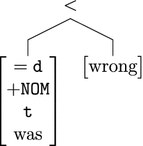
-
2.
step: Merge
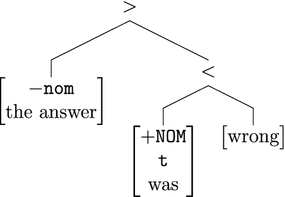
-
3.
step: Move
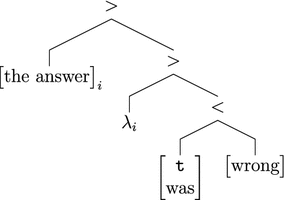
-
4.
step: Merge
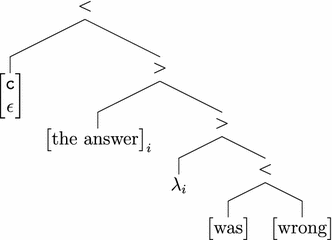
-
5.
step: Merge
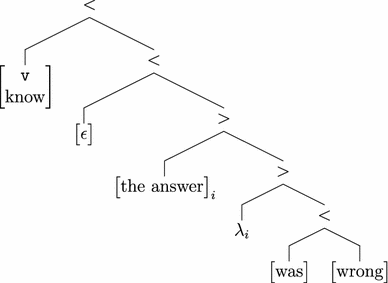
-
6.
step: Merge
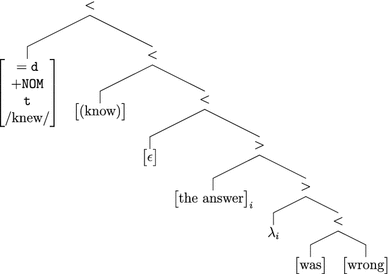
-
7.
step: Merge
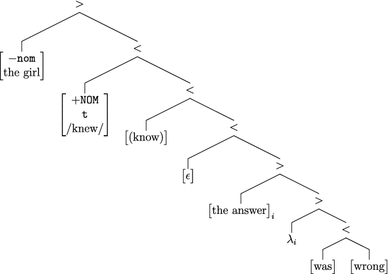
-
8.
step: Move
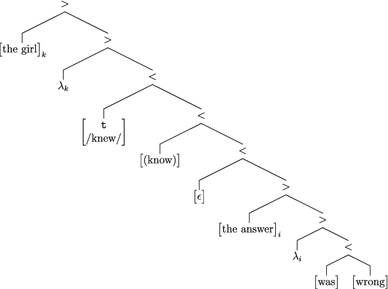
-
9.
step: Merge
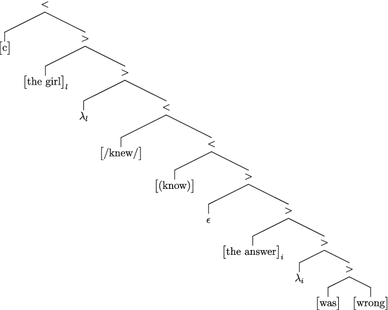
German examples
Der Detektiv hat die Kommissarin gesehen
-
1.
step: merge
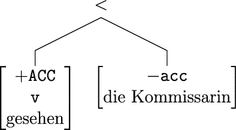
-
2.
step: move
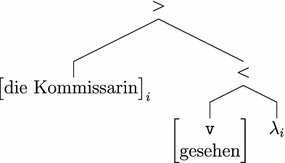
-
3.
step: merge
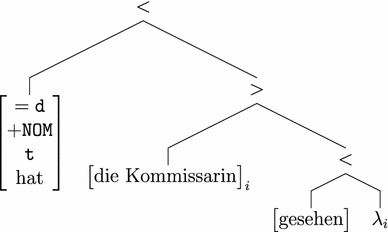
-
4.
step: merge
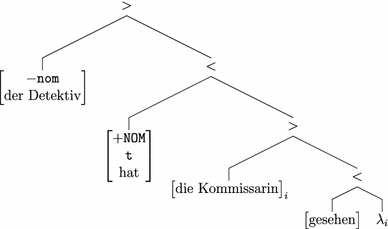
-
5.
step: move
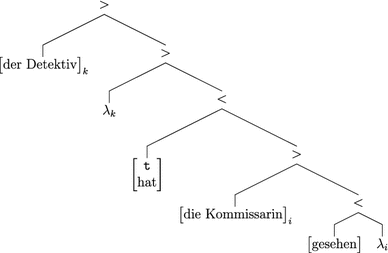
-
6.
step: merge
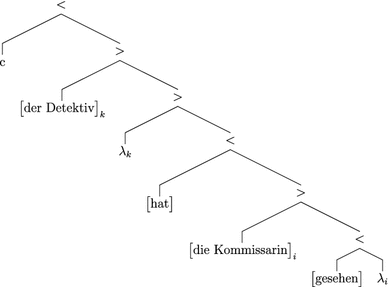
Die Detektivin hat den Kommissar gesehen
The sentence is parsed like the first sentence “Der Detektiv hat die Kommissarin gesehen.”
Den Detektiv hat die Kommissarin gesehen
-
1.
step: merge
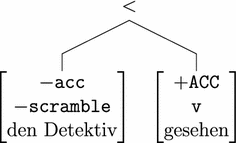
-
2.
step: move
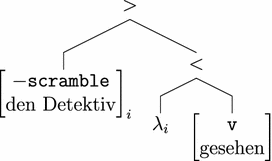
-
3.
step: merge

-
4.
step: merge
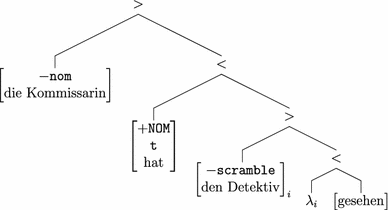
-
5.
step: move
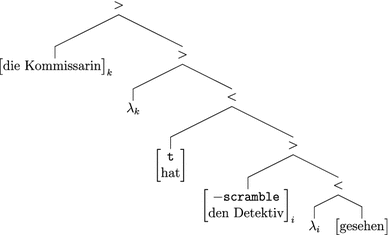
-
6.
step: merge(head movement)

-
7.
step: move(scrambling)
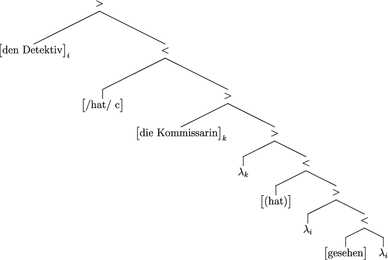
Die Detektivin hat der Kommissar gesehen
-
1.
step: merge

-
2.
step: move
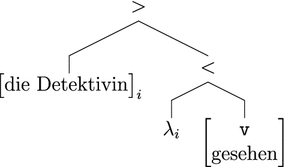
-
3.
step: merge

-
4.
step: merge
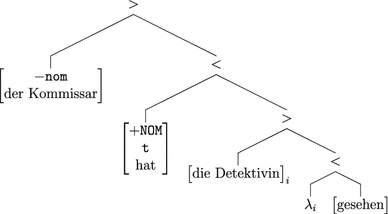
-
5.
step: move
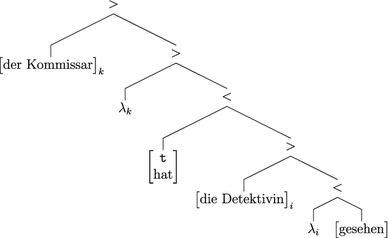
-
6.
step: merge(head movement)
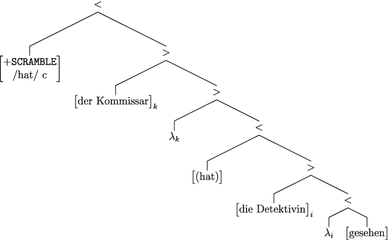
At this point the derivation of the sentence terminates because there are no more features that could be checked. As there is still the licensor for the scrambling operation left the sentence is grammatically not well-formed and is not accepted by the grammar formalism.
Rights and permissions
About this article
Cite this article
Gerth, S., beim Graben, P. Unifying syntactic theory and sentence processing difficulty through a connectionist minimalist parser. Cogn Neurodyn 3, 297–316 (2009). https://doi.org/10.1007/s11571-009-9093-1
Received:
Accepted:
Published:
Issue Date:
DOI: https://doi.org/10.1007/s11571-009-9093-1
































